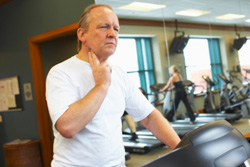
SBM Helping to Bring Behavioral Science to ACSM's Exercise is Medicine® Initiative
Matthew P. Buman, PhD, Stanford University School of Medicine
NiCole R. Keith, PhD, FACSM, Indiana University-Purdue University, Indianapolis
 SBM leadership and members of the Physical Activity Special Interest Group (SIG) have recently begun working with the American College of Sports Medicine (ACSM) on their Exercise is Medicine® (EIM) initiative. The objectives of the EIM initiative are to make physical activity a "vital sign" that is routinely assessed at every patient interaction with a health care provider, and to encourage primary care physicians and other health care providers to include exercise and physical activity when designing treatment plans for patients. ACSM is systematically identifying ways in which the "vital sign" routine assessment can be implemented, and partnering with SBM to more fully develop the program referral process and overall access to evidence-based behavioral interventions in order to provide stronger scientific support for the initiative.
SBM leadership and members of the Physical Activity Special Interest Group (SIG) have recently begun working with the American College of Sports Medicine (ACSM) on their Exercise is Medicine® (EIM) initiative. The objectives of the EIM initiative are to make physical activity a "vital sign" that is routinely assessed at every patient interaction with a health care provider, and to encourage primary care physicians and other health care providers to include exercise and physical activity when designing treatment plans for patients. ACSM is systematically identifying ways in which the "vital sign" routine assessment can be implemented, and partnering with SBM to more fully develop the program referral process and overall access to evidence-based behavioral interventions in order to provide stronger scientific support for the initiative.
The goals of the SBM-ACSM partnership are to (a) identify evidence-based interventions that are scalable at the national level and have the potential to cut across a wide range of healthcare delivery settings; (b) work with ACSM and other organizations to effect this type of translation and scalability; and (c) identify and/or develop the most effective types of referral systems to enact the link between the primary care office referral and the program delivery source.
At the 58th ACSM Annual Meeting and 2nd World Congress on Exercise is Medicine® in May-June 2011 in Denver, CO, SBM members met with the ACSM leadership and members to discuss short- and long-term plans for moving this partnership forward. Short-term plans include the identification of evidence-based physical activity programs that have promise for widespread dissemination across communities and healthcare settings. One of the initial plans will be to focus on web-based and telephone-linked systems that promote initiation and long-term maintenance of physical activity behavior. Promising evidence-based programs will be identified and translational efforts to scale up such programs will be discussed. Longer-term plans include identifying other types of physical activity programs (e.g., community-based approaches, brief healthcare professional based advice/programs) that have the potential for scalability and integrating the referral process into the medical record. Plans are underway to evaluate short- and long-term behavioral outcomes as well as the translation/dissemination process from start to finish.
Our hope is that initial success in identifying existing evidence-based programs with potential for scalability will lead to deeper and even more productive collaborations between SBM and ACSM with the EIM® initiative being a focus of these initial interactions.